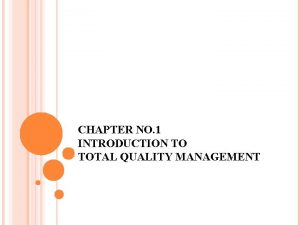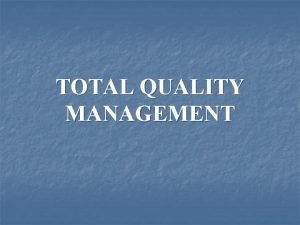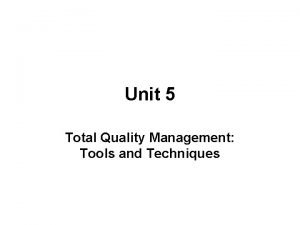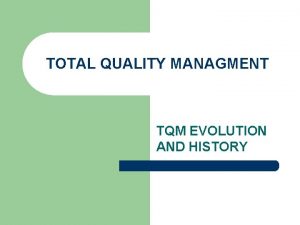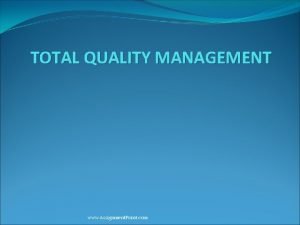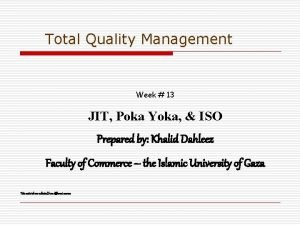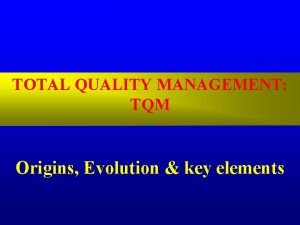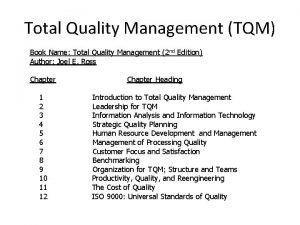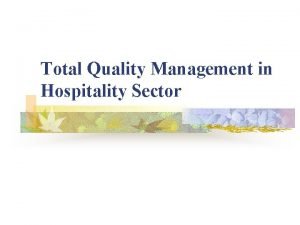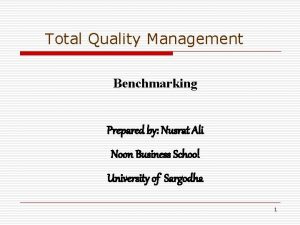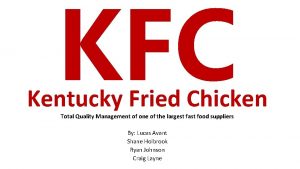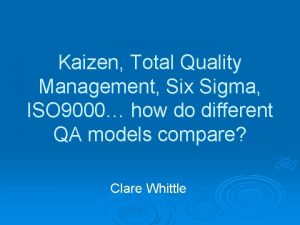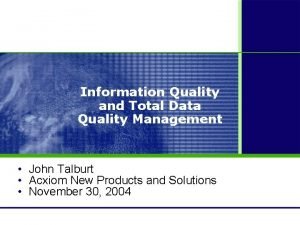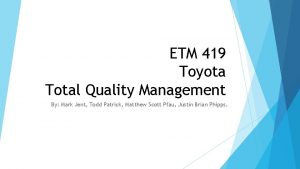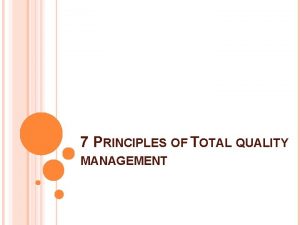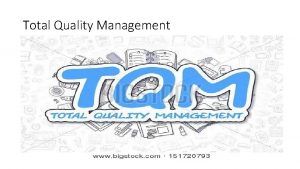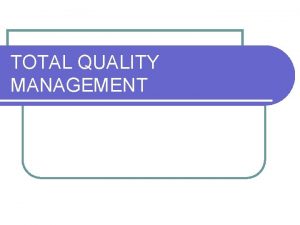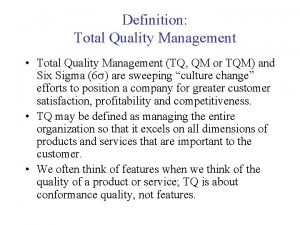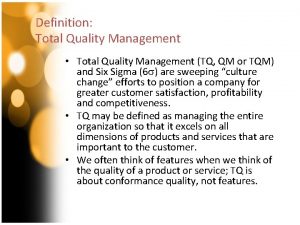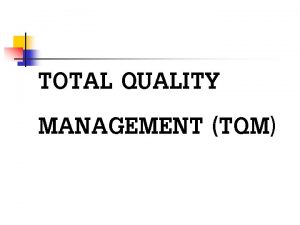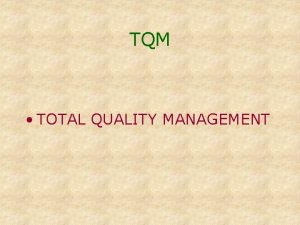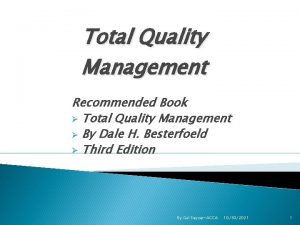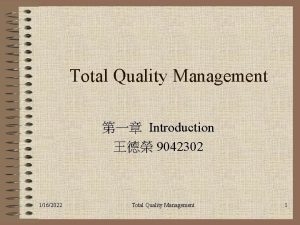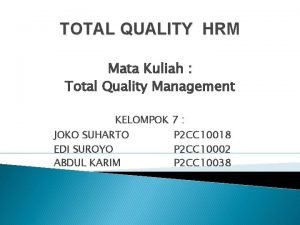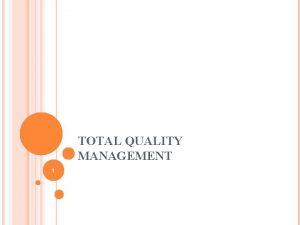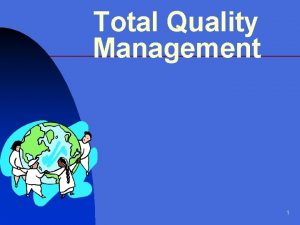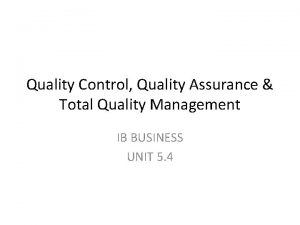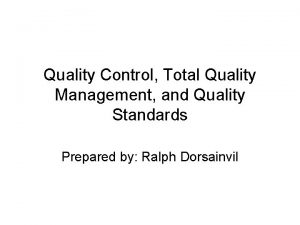CHAPTER NO 1 INTRODUCTION TO TOTAL QUALITY MANAGEMENT




















- Slides: 20

CHAPTER NO. 1 INTRODUCTION TO TOTAL QUALITY MANAGEMENT

TQM Total – Made up of the whole(or) Complete. Quality – Degree of Excellence a product or service provides to the customer in present and future. Management – Act , art, or manner of handling , controlling, directing, etc. TQM is the art of managing the whole to achieve excellence. Total Qual ity Man age ment

QUALITY What is quality? Dictionary has many definitions: “Essential characteristic, ” “Superior, ” etc. “ Quality is the totality of features and characteristics of a product or service that bears on its ability to satisfy given needs. ” 3

VARIOUS DEFINITIONS OF QUALITY Fitness for purpose or use. (-Juran) Quality is conformance to requirements (-Crosby) Quality should be aimed at the needs of the customer, present and future. (- Deming) Quality is the degree of excellence at an acceptance price and control of variability at an acceptable cost (- Broh) 4

Quality meets the requirements of the customers, both internal and external, the organization for defect – free product, services and business processes. (-IBM) Total Composite of product and service characteristics of marketing, engineering, manufacturing and maintenance through which the product and service in use will meet the expectation by the customer. (- Feigenbaum) Quality is a dynamic state associated with products, services, people, processes and environments that meets or exceeds expectations. Quality is the value to someone (-Weinberg) 5

THE 9 DIMENSIONS OF QUALITY Performance Features Conformance --------------Reliability Durability Service --------------Response- of Dealer/ Mfgr. to Customer Aesthetics – of product Reputation- of Mfgr. /Dealer Performance Cost Service Features

TQM What is TQM? A comprehensive, organization-wide effort to improve the quality of products and services, applicable to all organizations. Total Quality Management (TQM) is a system of principles, methods, and best practices that provide a framework for organizations to strive for excellence in everything they do. 7

TQM SIX BASIC CONCEPTS Management commitment to TQM principles and methods & long term Quality plans for the Organization Focus on customers – internal & external Quality at all levels of the work force. Continuous improvement of the production/business process. Treating suppliers as partners Establish performance measures for the processes.

WHAT IS A CUSTOMER? Anyone who is impacted by the product or process delivered by an organization. External customer: The end user as well as intermediate processors. Other external customers may not be purchasers but may have some connection with the product. Internal customer: Other divisions of the company that receive the processed product. What is a product? The output of the process carried out by the organization. It may be goods (e. g. automobiles, missile), software (e. g. a computer code, a report) or service (e. g. banking, insurance) 9

HOW IS CUSTOMER SATISFACTION ACHIEVED? Two dimensions: Product features and Freedom from deficiencies. Product features – Refers to quality of design. Examples in manufacturing industry: Performance, Reliability, Durability, Ease of use, Esthetics etc. Examples in service industry: Accuracy, Timeliness, Friendliness and courtesy, Knowledge of server etc. Freedom from deficiencies – Refers to quality of conformance. Higher conformance means fewer complaints and increased customer satisfaction. 10

WHY QUALITY? Reasons for quality becoming a cardinal priority for most organizations: Competition – Today’s market demand high quality products at low cost. Having `high quality’ reputation is not enough! Internal cost of maintaining the reputation should be less. Changing customer – The new customer is not only commanding priority based on volume but is more demanding about the “quality system. ” Changing product mix – The shift from low volume, high price to high volume, low price have resulted in a need to reduce the internal cost of poor quality. 11

WHY QUALITY? Product complexity – As systems have become more complex, the reliability requirements for suppliers of components have become more stringent. Higher levels of customer satisfaction – Higher customers expectations are getting spawned by increasing competition. Relatively simpler approaches to quality viz. product inspection for quality control and incorporation of internal cost of poor quality into the selling price, might not work for today’s complex market environment. 12

QUALITY PERSPECTIVES 1. 2. 3. 4. 5. 6. 7. 8. Everyone defines Quality based on their own perspective of it. Typical responses about the definition of quality would include: Perfection Consistency Eliminating waste Speed of delivery Compliance with policies and procedures Doing it right the first time Delighting or pleasing customers Total customer satisfaction and service 13

QUALITY PERSPECTIVES Judgmental perspective “goodness of a product. ” Shewhart’s transcendental definition of quality – “absolute and universally recognizable, a mark of uncompromising standards and high achievement. ” Examples of products attributing to this image: Rolex watches, Lexus cars. Product-based perspective “function of a specific, measurable variable and that differences in quality reflect differences in quantity of some product attributes. ” Example: Quality and price perceived relationship. 14

QUALITY PERSPECTIVES User-based perspective “fitness for intended use. ” Individuals have different needs and wants, and hence different quality standards. Example – Nissan offering ‘dud’ models in US markets under the brand name Datson which the US customer didn’t prefer. Value-based perspective “quality product is the one that is as useful as competing products and is sold at a lesser price. ” US auto market – Incentives offered by the Big Three are perceived to be compensation for lower quality. 15

QUALITY PERSPECTIVES Manufacturing-based perspective “the desirable outcome of a engineering and manufacturing practice, or conformance to specification. ” Engineering specifications are the key! Example: Coca-cola – “quality is about manufacturing a product that people can depend on every time they reach for it. ” 16

QUALITY LEVELS At organizational level, we need to ask following questions: Which products and services meet your expectations? Which products and services you need that you are not currently receiving? At process level, we need to ask: What products and services are most important to the external customer? What processes produce those products and services? What are the key inputs to those processes? Which processes have most significant effects on the organization’s performance standards? 17

QUALITY LEVELS At the individual job level, we should ask: What is required by the customer? How can the requirements be measured? What is the specific standard for each measure? 18

EFFECTS OF POOR QUALITY Low customer satisfaction Low productivity, sales & profit Low morale of workforce More re-work, material & labour costs High inspection costs Delay in shipping High repair costs Higher inventory costs Greater waste of material

BENEFITS OF QUALITY Higher customer satisfaction Reliable products/services Better efficiency of operations More productivity & profit Better morale of work force Less wastage costs Less Inspection costs Improved process More market share Spread of happiness & prosperity Better quality of life for all.
 Introduction to total quality management
Introduction to total quality management Introduction to quality management
Introduction to quality management Introduction of tqm
Introduction of tqm Contemporary management practice
Contemporary management practice Operations management with total quality management book
Operations management with total quality management book Interrelationship diagram
Interrelationship diagram Tqm inventor
Tqm inventor Assignment point
Assignment point Poka yoka
Poka yoka Total quality management system
Total quality management system Key elements of tqm
Key elements of tqm Tqm book
Tqm book Tqm in hospitality industry
Tqm in hospitality industry Benchmarking in total quality management
Benchmarking in total quality management Management gurus and their contributions
Management gurus and their contributions Quality assurance model in nursing management
Quality assurance model in nursing management Tqm of kfc
Tqm of kfc Kaizen total quality management
Kaizen total quality management Total data quality management
Total data quality management Toyota tqm
Toyota tqm Quality management is not a quick fix
Quality management is not a quick fix

